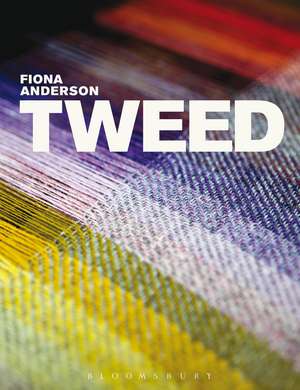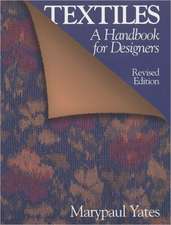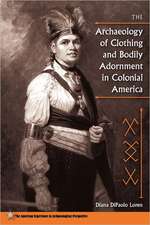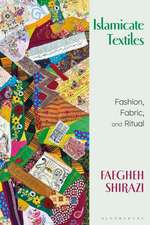Tweed: Textiles that Changed the World
Autor Fiona Andersonen Limba Engleză Paperback – 14 dec 2016
Preț: 189.63 lei
Preț vechi: 210.64 lei
-10% Nou
Puncte Express: 284
Preț estimativ în valută:
36.28€ • 37.88$ • 30.03£
36.28€ • 37.88$ • 30.03£
Carte tipărită la comandă
Livrare economică 04-18 aprilie
Preluare comenzi: 021 569.72.76
Specificații
ISBN-13: 9781845206970
ISBN-10: 1845206975
Pagini: 232
Ilustrații: 55 bw and 22 colour illus
Dimensiuni: 189 x 246 x 14 mm
Greutate: 1.23 kg
Editura: Bloomsbury Publishing
Colecția Bloomsbury Academic
Seria Textiles that Changed the World
Locul publicării:London, United Kingdom
ISBN-10: 1845206975
Pagini: 232
Ilustrații: 55 bw and 22 colour illus
Dimensiuni: 189 x 246 x 14 mm
Greutate: 1.23 kg
Editura: Bloomsbury Publishing
Colecția Bloomsbury Academic
Seria Textiles that Changed the World
Locul publicării:London, United Kingdom
Caracteristici
Explores the considerable international influence of tweed and its links with major social and cultural changes in terms of class, gender and local and national identities
Notă biografică
Fiona Anderson lectures at Edinburgh College of Art, University of Edinburgh, UK, and works as an Independent Curator. She was formerly Senior Curator of Fashion and Textiles at National Museums Scotland, UK.
Cuprins
List of IllustrationsAcknowledgements1. Introduction2. Tweed: Terms, Descriptions and Characteristics 3. Origins and Early Development of Tweed to 18504. Tweed, Male Fashion and Modern Masculinities 1851-1918 5. Tweed, Femininity and Fashion 1851-1918 6. Suits You: Men and Tweed 1919-19527. Sportswear Chic: Tweed in Womenswear 1919 to 19528. Couture to Pop and Nostalgic Fashion: 1953 to 19809. Tradition and Innovation: 1981 to 2014 BibliographyIndex
Recenzii
For textile history enthusiasts, or weavers of tweed yardage pondering the background to the iconic cloth ... this book will be if great interest ... By the final chapters you will have gained a fascinating insight into this industry.
Anderson's excellent book Tweed offers a detailed examination of the history of tweed as both fabric and garment. In so doing she unpacks some of the wideranging social and cultural themes that are hinted at in the exchange between Lord Peter Wimsey and his manservant Bunter ... an excellent overview of a complex subject, demonstrating the value of placing one fabric at the centre of a rich multi-disciplinary enquiry.
This book provides a model of how to write a biography of a fabric, which through developing so many unexpected links and thought-provoking digressions leaves the reader with an entirely new perspective on the subject.
Tweed delivers coherent and precise conclusions that are testament to the thorough research that it contains ... an excellent and much-needed introduction to the topic that lays a strong foundation for other channels of research and interrogation of this fascinating textile.
The scope and quality of the research within Tweed is excellent. The author provides a nuanced account of this universally recognized but often misunderstood and under-researched textile, and firmly situates it within the context of broader economic, social and cultural histories.
Expansive and detailed, Fiona Anderson's Tweed offers a rigorous history of this important textile. Drawing on new research, it challenges the myths and sets its subject within its technical, cultural, and aesthetic contexts, pulling together questions of production, consumption and reception in a complex and satisfying weave of ideas.
From its beginnings in coarse woolen shepherd's checks to its global success in luxury markets, Fiona Anderson digs deep into the life of tweed - its history, myths, meanings, design, technical characteristics, and consumption. The study considers tweed from a broad perspective of innovation and fashion change, aided largely by a material culture approach. The relationship of tweed to class, gender, national identities and traditions, is part of the story. Readers will want to know more about these timeless fabrics that have romantic (and other) meanings long before they are fashioned into clothes.
Readers interested in the history of textiles will be intrigued to learn about the relationship of tweed to the artistic Romantic movement-which butted against industrialism and urbanism-and how this rural fabric became associated with idealized imperialism, travel, and foreign exoticism.
Anderson's excellent book Tweed offers a detailed examination of the history of tweed as both fabric and garment. In so doing she unpacks some of the wideranging social and cultural themes that are hinted at in the exchange between Lord Peter Wimsey and his manservant Bunter ... an excellent overview of a complex subject, demonstrating the value of placing one fabric at the centre of a rich multi-disciplinary enquiry.
This book provides a model of how to write a biography of a fabric, which through developing so many unexpected links and thought-provoking digressions leaves the reader with an entirely new perspective on the subject.
Tweed delivers coherent and precise conclusions that are testament to the thorough research that it contains ... an excellent and much-needed introduction to the topic that lays a strong foundation for other channels of research and interrogation of this fascinating textile.
The scope and quality of the research within Tweed is excellent. The author provides a nuanced account of this universally recognized but often misunderstood and under-researched textile, and firmly situates it within the context of broader economic, social and cultural histories.
Expansive and detailed, Fiona Anderson's Tweed offers a rigorous history of this important textile. Drawing on new research, it challenges the myths and sets its subject within its technical, cultural, and aesthetic contexts, pulling together questions of production, consumption and reception in a complex and satisfying weave of ideas.
From its beginnings in coarse woolen shepherd's checks to its global success in luxury markets, Fiona Anderson digs deep into the life of tweed - its history, myths, meanings, design, technical characteristics, and consumption. The study considers tweed from a broad perspective of innovation and fashion change, aided largely by a material culture approach. The relationship of tweed to class, gender, national identities and traditions, is part of the story. Readers will want to know more about these timeless fabrics that have romantic (and other) meanings long before they are fashioned into clothes.
Readers interested in the history of textiles will be intrigued to learn about the relationship of tweed to the artistic Romantic movement-which butted against industrialism and urbanism-and how this rural fabric became associated with idealized imperialism, travel, and foreign exoticism.



















